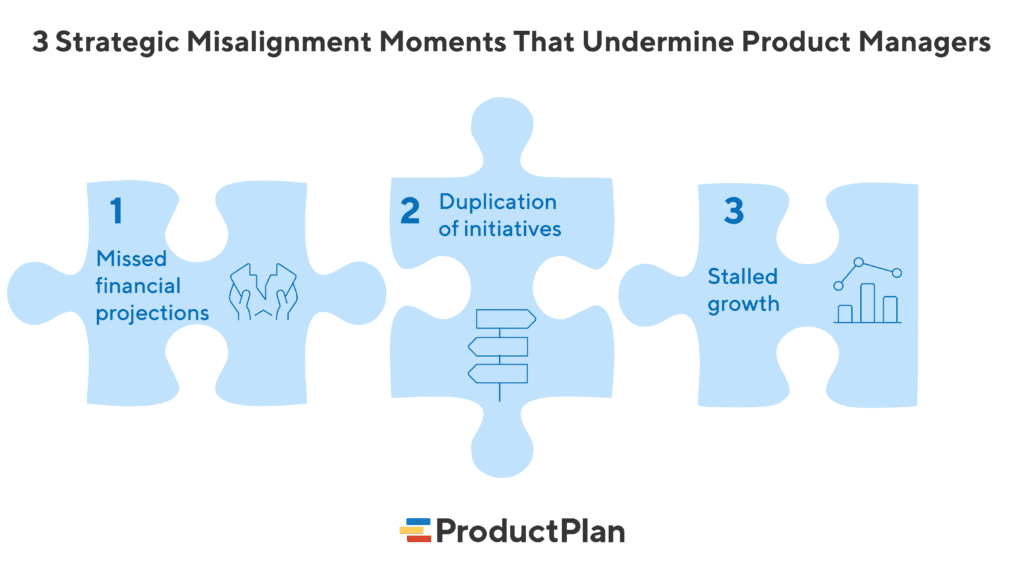For a product professional guiding the work of a team, strategic alignment should be the holy grail. Achieving it won’t be easy. To get there, you’ll need a lot of smaller successes. Including making sure that everyone involved has a shared understanding of the big goals for the product. Second, all teams agree on a definition of success. Third, each team translates the strategy into the right tasks in the proper order. Finally, you must have a realistic understanding of the market, your team’s strengths and weaknesses, and your product’s potential for success. If you or your team fall short in any of these areas, you risk strategic misalignment.
That can lead to all sorts of problems for your team, your product, and your business. Let’s review a few common ways product managers fall into the strategic misalignment trap—and discuss what you can do to avoid them.

3 Strategic Misalignment Moments That Undermine Product Managers
1. Missed financial projections
Product managers are a naturally optimistic bunch. That’s great, but it has a downside.
In our 2021 State of Product Management report, ProductPlan found that more than 72% of all product managers describe themselves as “mostly happy” or “extremely happy” in their jobs. You’re not going to feel happy at work—let alone extremely happy—if you don’t think your products will succeed.
Here’s the challenge: An optimistic product manager is more vulnerable to imagining their products’ best possible outcome. It’s important to be enthusiastic about an upcoming product launch and share that enthusiasm with your team and stakeholders. But it’s also important to take a realistic view of the market, your competitors, and your company’s sales and marketing abilities.
Why does this happen?
Product teams can fall short of their financial projections for any number of reasons. As millions of businesses learned in 2020, sometimes the factors that can sink a product or service are completely out of the company’s control.
But what often causes this is that the product manager takes too rosy a view of how their product will perform. The product manager might overestimate the size of the available market or underestimate the strength of the company’s competitors.
Then they communicate this overly positive view to the company—and everyone is disappointed when reality doesn’t measure up.
What can you do about it?
Two ideas come to mind here.
First, learn how to set expectations with your stakeholders. You can communicate enthusiasm about your product’s revenue potential without overpromising—in fact, without promising at all.
Second, create multiple sets of financial projections. Come up with estimates based on best case, most likely, and worst-case scenarios. You’ll also want to be ready with examples of factors that could lead to each scenario. This will help you prepare your company for all possibilities.
2. Duplication of initiatives
Successful product development requires many teams. But these teams are working on different areas of the product in parallel and making the best use of its resources.
Without a clear understanding of what each team should be doing, a company can find itself behind schedule, waste development cycles, and miss revenue due to a delayed product release.
Two common examples of duplication of initiatives include two teams working on the same thing or the company forced to redo work because they completed it incorrectly the first time.
Why does this happen?
In our experience working with thousands of product professionals, we’ve found the top reason for both of these types of duplicating efforts is poor communication and coordination.
When product managers don’t have a process or the right tools to keep everyone up to date, it will be easy for two development teams to work on the same functionality.
What can you do about it?
One useful tool that can help you avoid work duplication is a product roadmap that all teams can access anytime. And because you might update the roadmap at any time, it makes sense to use a web-based roadmap app—so there’s just one version online that’s always accurate. For more ideas on this, read our post about how to make your product roadmaps more collaborative.
Another pro tip: Make sure you select a roadmap app that integrates with task management tools like Jira and with team collaboration apps such as Slack.
By integrating Jira into your roadmap, you’ll make it easier for everyone to see the status of product epics and other issues. That makes it a lot less likely two teams will spend their time working on the same thing.
And if you can integrate your roadmap with Slack, you can make sure all teams automatically get notified anytime someone updates the roadmap. This is another way to reduce the chances of duplicate work.

3. Stalled growth
This is one of the most frustrating types of strategic misalignment for a product team. It often strikes suddenly and follows a period when the company was celebrating product success.
But what product managers need to understand—and communicate to their teams—is that all products go through different stages. Slowed growth is inevitable. Even the most successful product in the world will slow its rate of growth at some point.
Why does this happen?
There’s a consensus among the product community that products have a four-stage lifecycle: introduction, growth, maturity, and decline. A successful app like Slack is still in its growth phase. Microsoft PowerPoint, on the other hand, entered maturity years ago.
In other words, your product’s growth could have stalled simply because the product has entered the next stage of its lifecycle. You’ve already taken the lion’s share of interested customers in your market, and now it’s time to continue serving those users and the smaller number of new ones who sign on each year.
But here’s another possibility your product has stalled: You didn’t develop a strong product-market fit. Maybe your launch succeeded because your company had a great marketing and sales strategy. Early adopters flocked to try your product. The quick spike in sales misled your team into thinking the product would continue winning customers at an increasing rate.
What can you do about it?
If growth stalled simply because your product moved from the growth to the maturity phase, there’s not much you can do. That slowed growth is part of the product lifecycle.
At that point, your tasks will be to 1) explain to your stakeholders that they cannot expect infinite growth in sales for any product and 2) to start working on another product that can enjoy a new wave of growth.
But if the stalled growth is due to something more troubling, such as the fact that the eager market you thought existed for the product doesn’t exist, then you have another task: Find a product-market fit.
Product Roadmapping: A Simple Strategy to Combat Strategic Misalignment
The examples above are just a few of strategic misalignments that can undermine a product team’s work. All types of misalignment have in common a lack of communication.
One simple strategy for product managers to reduce these communication failures across the company is to build a product roadmap that serves as everyone’s strategic guidepost and a single source of truth.
Fortunately, building a visual, strategically compelling roadmap is faster and easier than ever. You can create a roadmap in just minutes online, and share the link with your whole team, to make sure everyone is strategically aligned.




